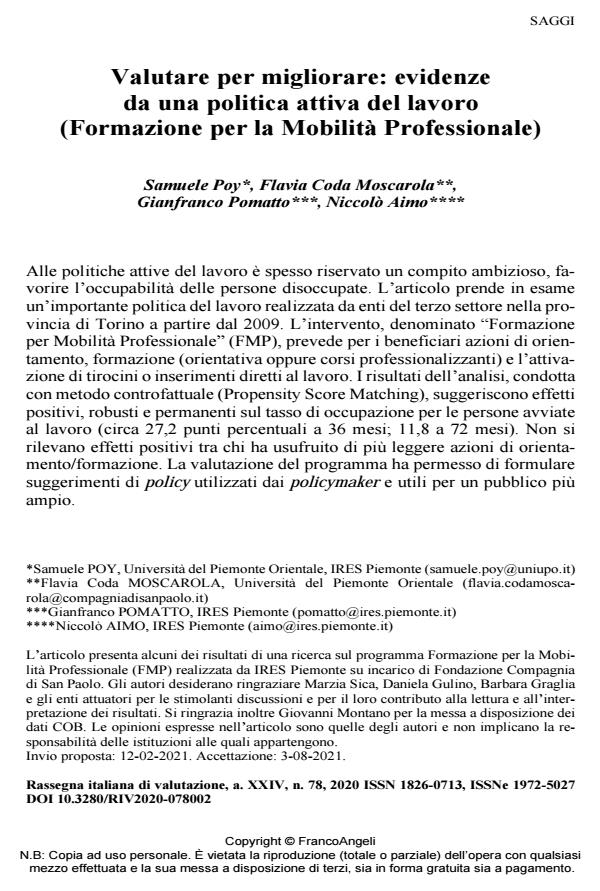Valutare per migliorare: evidenze da una politica attiva del lavoro (Formazione per la Mobilità Professionale)
Journal title RIV Rassegna Italiana di Valutazione
Author/s Samuele Poy, Flavia Coda Moscarola, Gianfranco Pomatto, Niccolò Aimo
Publishing Year 2022 Issue 2020/78
Language Italian Pages 28 P. 11-38 File size 331 KB
DOI 10.3280/RIV2020-078002
DOI is like a bar code for intellectual property: to have more infomation
click here
Below, you can see the article first page
If you want to buy this article in PDF format, you can do it, following the instructions to buy download credits

FrancoAngeli is member of Publishers International Linking Association, Inc (PILA), a not-for-profit association which run the CrossRef service enabling links to and from online scholarly content.
- Arendt J. N., Andersen H. L., Saaby M. (2020), The Relationship between Active Labor Market Programs and Employability of the Long-term Unemployed, Labour, 34(2), 154-175.
- Ashenfelter O., Card D. (1985). Using the longitudinal structure of earnings to estimate the effect of training programs. Review of Economics and Statistics, 67(4), 648-660.
- Bazzoli M., De Poli S., Rettore E., Schizzerotto A. (2018). Are vocational training programmes worth their cost? Evidence from a cost-benefit analysis. Politica economica, 34(3), 215-240. DOI: 10.1429/92119
- Benda L., Koster F., & Van Der Veen R. (2020). Activation is not a panacea: active labour market policy, long-term unemployment and institutional complementarity. Journal of Social Policy, 49(3), 483-506.
- Bratu C., Lombardi S., Rodrigues M., Santangelo G., Shaleva A. (2014). Knowledge gaps in evaluating labour market and social inclusion policies. European Commission Joint Research Centre, Ispra. DOI: 10.2788/083390
- Caliendo M., Mahlstedt R., Mitnik O. (2017). Unobservable, but unimportant? The relevance of usually unobserved variables for the evaluation of labor market policies. Labour Economics, 46.
- Card D., Kluve J., Weber A. (2016). Active labour market policies and long term unemployement. In: Bentolila, S., Jansen, M., a cura di, Long-Term Unemployment After the Great Recession: Causes and remedies. Londra: CEPR Press.
- Card D., Kluve J., Weber A. (2018). What works? A meta analysis of recent active labor market program evaluations. Journal of the European Economic Association, 16, 894-931.
- Card D., Sullivan D. (1988). Measuring the effect of subsidized training programs on movements in and out of employment. Econometrica, 56(3), 497-530.
- Costabella L. M. (2014). Stimare gli effetti della formazione professionale rivolta ai disoccupati-Illustrazione di un’esperienza di valutazione in Piemonte. Rassegna Italiana di Valutazione, 60, 45-64. DOI: 10.3280/RIV2014-060004
- Costabella L.M. (2017). Do high school graduates benefit from intensive vocational training?.International Journal of Manpower, 38(5), 746-764.
- Crepon B., van den Berg G. J. (2016). Active Labor Market Policies, IZA Annual Review of Economics, 8, 521-546.
- Croce G. (2020). Le politiche attive del lavoro nella crisi da Covid-19, Economia & Lavoro,2, 91-116. DOI: 10.7384/98577
- Donato L., Migliore M. C., Poy S. (2018). Employment effects of vocational training: An evaluation using propensity score matching. Politica economica, 34(3), 273-296. DOI: 10.1429/92121
- Duranti S., Sciclone N. (2017). La formazione professionale in Toscana. Monitoraggio e valutazione delle attività, IRPET.
- Ecorys I. (2012). Analysis of costs and benefits of active compared to passive measures.
- Escudero V. (2015). Are active labour market policies effective in activating and integrating low skilled individuals? An international comparison. ILO working papers.
- Greer I., Schulte L., Symon G. (2018). Creaming and parking in marketized employment services; an Anglo-German comparison. Human relations, 71(11), 1427-1453. DOI: 10.1177/0018726717745958
- Grimm M., Paffhausen A. L. (2015). Do interventions targeted at micro-entrepreneurs and small and medium-sized firms create jobs? A systematic review of the evidence for low and middle income countries. Labour Economics, 32, 67-85.
- Lammers M., Kok L. (2019). Are active labor market policies (cost-)effective in the long run? Evidence from the Netherlands. Empirical Economics.
- Levy-Yeyati E., Montané M., Sartorio L. (2019), What Works for Active Labor Market Policies?, CID Faculty Working Papers, n. 358.
- Martin J. M. (2014). Activation and Active Labour Market Policies in OECD Countries: Stylized Facts and Evidence on their Effectiveness. IZA Policy Paper, 84.
- OECD. (2019). Strengthening Active Labour Market Policies in Italy. Connecting People with Jobs, OECD Publishing, Paris.
- Pomatto G., Poy S., Aimo N. (2021). Politiche attive del lavoro ed effetti occupazionali Il caso del Buono per servizi al lavoro della Regione Piemonte. Rivista Italiana di Politiche Pubbliche, 16(2), 259-293.
- Rosenbaum P.R., Rubin D.B. (1983). The Central Role of the Propensity Score in Observational Studies for Causal Effect, Biometrika, 70(1), 41-55.
- Senghaas M., Freier C., Kupka P. (2018). Practices of Activation in Frontline In-teractions: Coercion, Persuasion, and the Role of Trust in Activation Policies in Ger-many, Social Policy & Administration, 53(5), 1-14.
- Shore J., Tosun J. (2019). Assessing Youth Labour Market Services: Young People’s Perceptions and Evaluations of Service Delivery in Germany, Public Policy and Administration, 34(1), 22-41.
- Weishaupt J., T. (2011). From the manpower revolution to the activation paradigm. Explaining institutional continuity and change in an integrating Europe. Amsterdam University Press.
Samuele Poy, Flavia Coda Moscarola, Gianfranco Pomatto, Niccolò Aimo, Valutare per migliorare: evidenze da una politica attiva del lavoro (Formazione per la Mobilità Professionale) in "RIV Rassegna Italiana di Valutazione" 78/2020, pp 11-38, DOI: 10.3280/RIV2020-078002